Toyota HRM Practices: Workforce Planning, Engagement, and Evaluation
VerifiedAdded on 2024/06/05
|21
|5599
|215
Report
AI Summary
This report provides a comprehensive analysis of Human Resource Management (HRM) practices within Toyota PLC. It begins with an overview of the organization and explains the purpose and functions of HRM, including workforce planning, recruitment, and employee relations. The report assesses Toyota's approaches to workforce planning, recruitment, selection, development, training, performance management, and reward systems. It evaluates the effectiveness of employee relations and engagement, flexible working practices, and Toyota's standing as an employer of choice. Furthermore, the report identifies and evaluates key areas of employment legislation relevant to the organization. Finally, it offers a brief evaluation of the HRM processes and the rationale behind implementing appropriate HR practices within Toyota PLC, highlighting the importance of aligning HR strategies with overall business goals to enhance organizational performance.
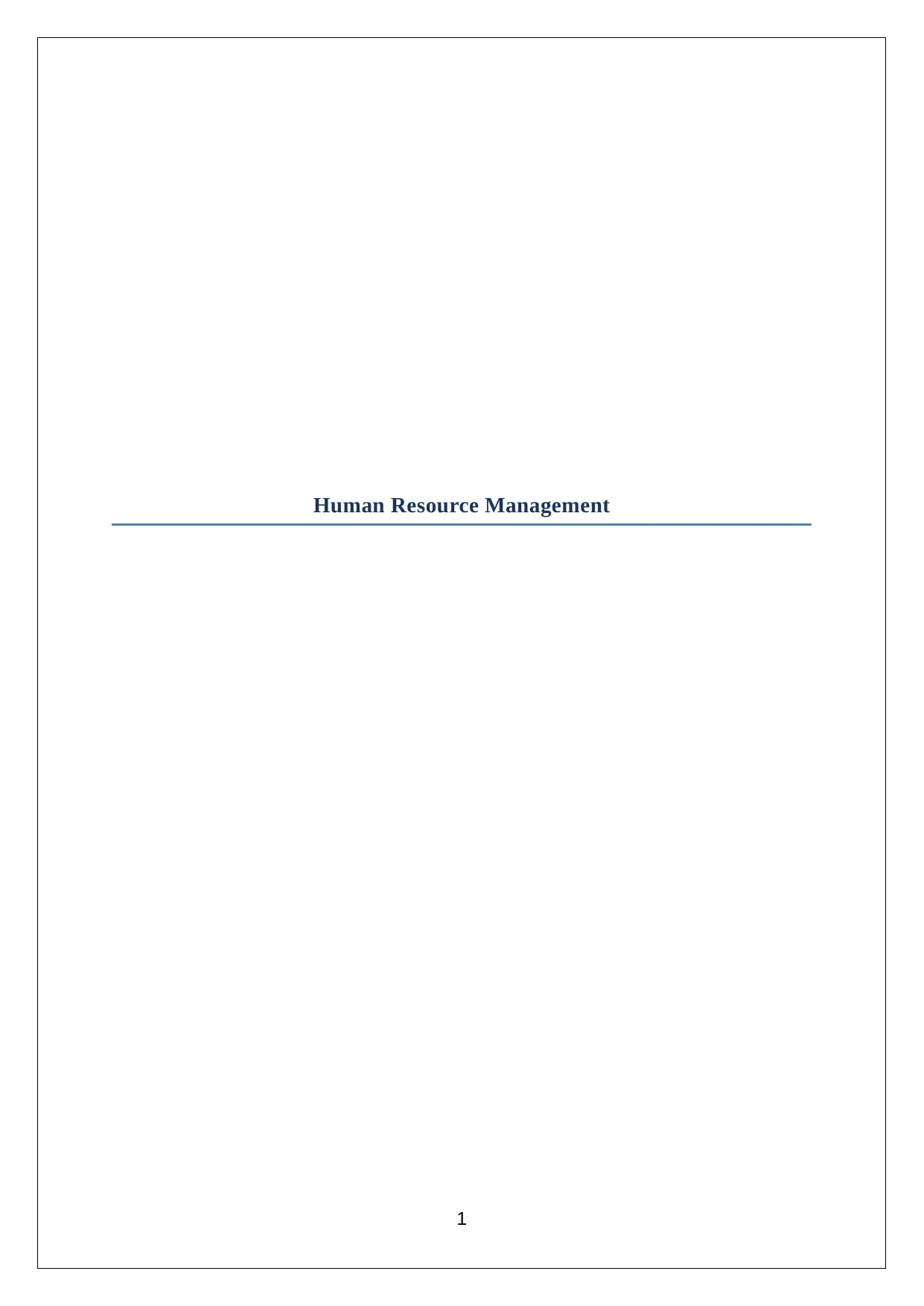
Human Resource Management
1
1
Paraphrase This Document
Need a fresh take? Get an instant paraphrase of this document with our AI Paraphraser
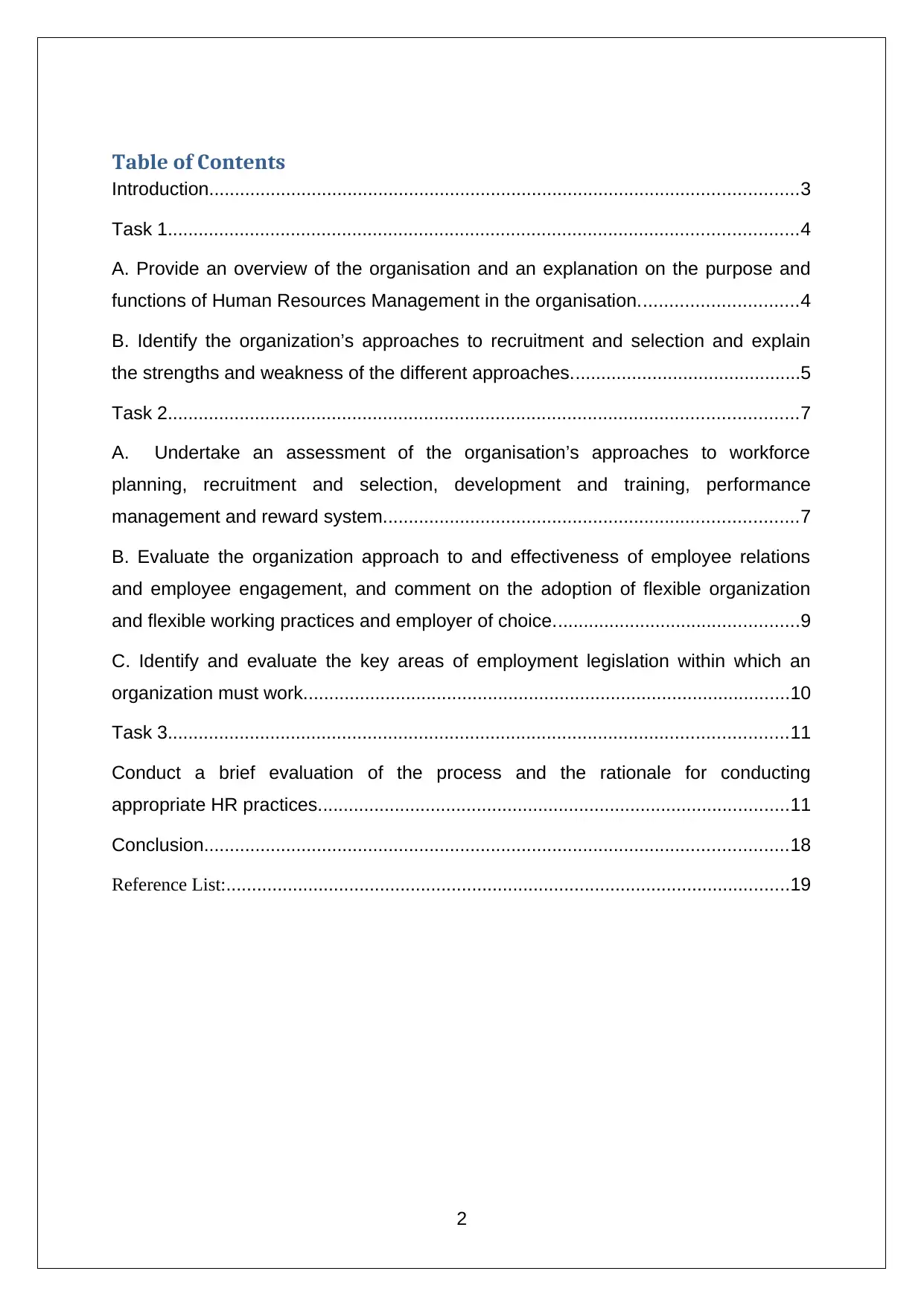
Table of Contents
Introduction...................................................................................................................3
Task 1...........................................................................................................................4
A. Provide an overview of the organisation and an explanation on the purpose and
functions of Human Resources Management in the organisation...............................4
B. Identify the organization’s approaches to recruitment and selection and explain
the strengths and weakness of the different approaches.............................................5
Task 2...........................................................................................................................7
A. Undertake an assessment of the organisation’s approaches to workforce
planning, recruitment and selection, development and training, performance
management and reward system.................................................................................7
B. Evaluate the organization approach to and effectiveness of employee relations
and employee engagement, and comment on the adoption of flexible organization
and flexible working practices and employer of choice................................................9
C. Identify and evaluate the key areas of employment legislation within which an
organization must work...............................................................................................10
Task 3.........................................................................................................................11
Conduct a brief evaluation of the process and the rationale for conducting
appropriate HR practices............................................................................................11
Conclusion..................................................................................................................18
Reference List:..............................................................................................................19
2
Introduction...................................................................................................................3
Task 1...........................................................................................................................4
A. Provide an overview of the organisation and an explanation on the purpose and
functions of Human Resources Management in the organisation...............................4
B. Identify the organization’s approaches to recruitment and selection and explain
the strengths and weakness of the different approaches.............................................5
Task 2...........................................................................................................................7
A. Undertake an assessment of the organisation’s approaches to workforce
planning, recruitment and selection, development and training, performance
management and reward system.................................................................................7
B. Evaluate the organization approach to and effectiveness of employee relations
and employee engagement, and comment on the adoption of flexible organization
and flexible working practices and employer of choice................................................9
C. Identify and evaluate the key areas of employment legislation within which an
organization must work...............................................................................................10
Task 3.........................................................................................................................11
Conduct a brief evaluation of the process and the rationale for conducting
appropriate HR practices............................................................................................11
Conclusion..................................................................................................................18
Reference List:..............................................................................................................19
2

Introduction
Human resource management is necessary to take into account in order to lead human
resources towards accomplishing business goals and objectives. In order to develop business
operation of an organisation, human resource strategy needs to be aligned with overall
organisational strategy. On the other hand, strategic human resource management is reliable
to promote behaviour of an organisation (Cascio, 2018).
This assignment aims to evaluate the role of human resource management within an
organisation. The study of this assignment intends to develop a case study report
demonstrating the application of HRM practice within an organisation named Toyota PLC
and to show the various benefits that the organization can utilize because of having a proper
Human Resource Management.
3
Human resource management is necessary to take into account in order to lead human
resources towards accomplishing business goals and objectives. In order to develop business
operation of an organisation, human resource strategy needs to be aligned with overall
organisational strategy. On the other hand, strategic human resource management is reliable
to promote behaviour of an organisation (Cascio, 2018).
This assignment aims to evaluate the role of human resource management within an
organisation. The study of this assignment intends to develop a case study report
demonstrating the application of HRM practice within an organisation named Toyota PLC
and to show the various benefits that the organization can utilize because of having a proper
Human Resource Management.
3
⊘ This is a preview!⊘
Do you want full access?
Subscribe today to unlock all pages.

Trusted by 1+ million students worldwide
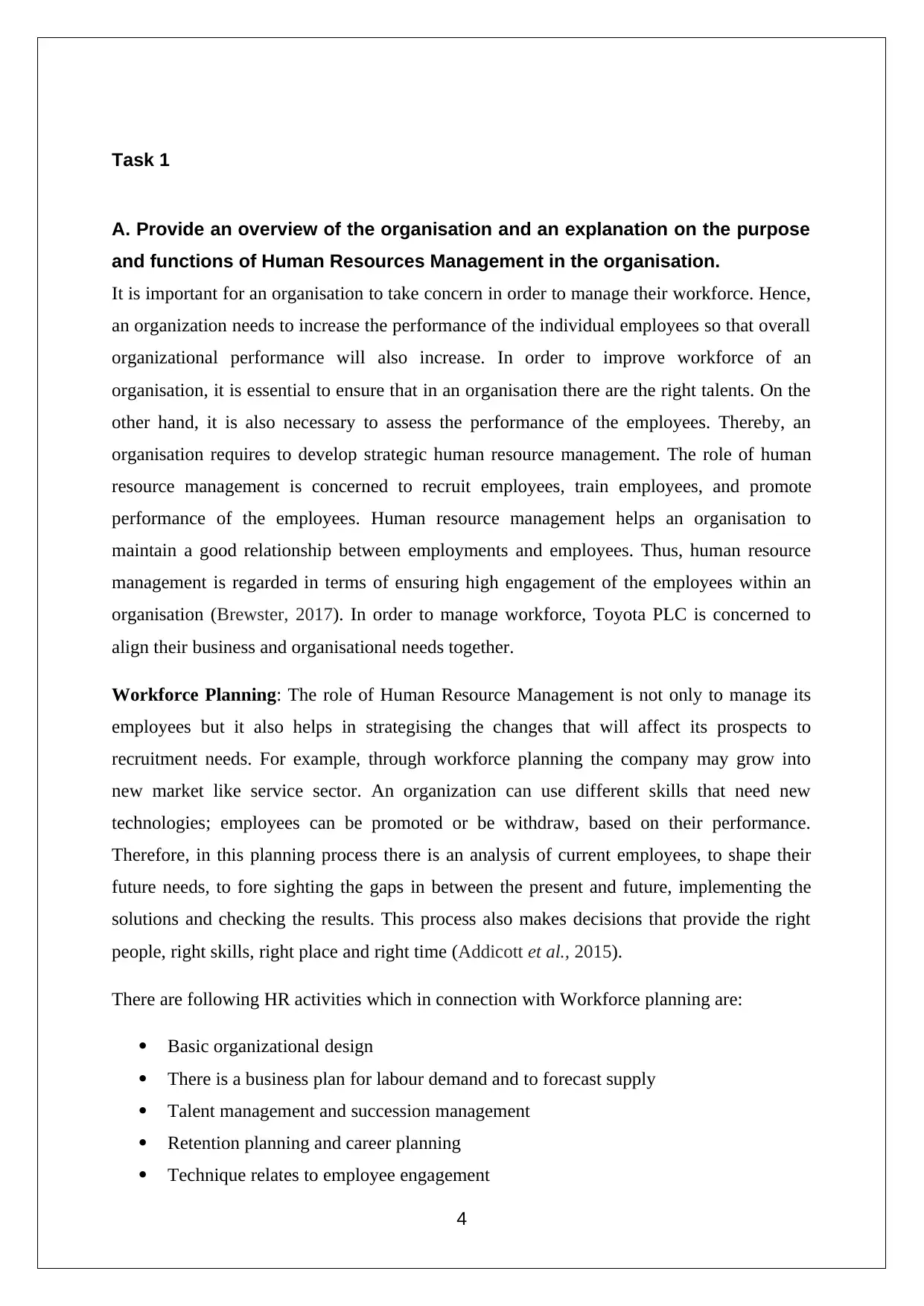
Task 1
A. Provide an overview of the organisation and an explanation on the purpose
and functions of Human Resources Management in the organisation.
It is important for an organisation to take concern in order to manage their workforce. Hence,
an organization needs to increase the performance of the individual employees so that overall
organizational performance will also increase. In order to improve workforce of an
organisation, it is essential to ensure that in an organisation there are the right talents. On the
other hand, it is also necessary to assess the performance of the employees. Thereby, an
organisation requires to develop strategic human resource management. The role of human
resource management is concerned to recruit employees, train employees, and promote
performance of the employees. Human resource management helps an organisation to
maintain a good relationship between employments and employees. Thus, human resource
management is regarded in terms of ensuring high engagement of the employees within an
organisation (Brewster, 2017). In order to manage workforce, Toyota PLC is concerned to
align their business and organisational needs together.
Workforce Planning: The role of Human Resource Management is not only to manage its
employees but it also helps in strategising the changes that will affect its prospects to
recruitment needs. For example, through workforce planning the company may grow into
new market like service sector. An organization can use different skills that need new
technologies; employees can be promoted or be withdraw, based on their performance.
Therefore, in this planning process there is an analysis of current employees, to shape their
future needs, to fore sighting the gaps in between the present and future, implementing the
solutions and checking the results. This process also makes decisions that provide the right
people, right skills, right place and right time (Addicott et al., 2015).
There are following HR activities which in connection with Workforce planning are:
Basic organizational design
There is a business plan for labour demand and to forecast supply
Talent management and succession management
Retention planning and career planning
Technique relates to employee engagement
4
A. Provide an overview of the organisation and an explanation on the purpose
and functions of Human Resources Management in the organisation.
It is important for an organisation to take concern in order to manage their workforce. Hence,
an organization needs to increase the performance of the individual employees so that overall
organizational performance will also increase. In order to improve workforce of an
organisation, it is essential to ensure that in an organisation there are the right talents. On the
other hand, it is also necessary to assess the performance of the employees. Thereby, an
organisation requires to develop strategic human resource management. The role of human
resource management is concerned to recruit employees, train employees, and promote
performance of the employees. Human resource management helps an organisation to
maintain a good relationship between employments and employees. Thus, human resource
management is regarded in terms of ensuring high engagement of the employees within an
organisation (Brewster, 2017). In order to manage workforce, Toyota PLC is concerned to
align their business and organisational needs together.
Workforce Planning: The role of Human Resource Management is not only to manage its
employees but it also helps in strategising the changes that will affect its prospects to
recruitment needs. For example, through workforce planning the company may grow into
new market like service sector. An organization can use different skills that need new
technologies; employees can be promoted or be withdraw, based on their performance.
Therefore, in this planning process there is an analysis of current employees, to shape their
future needs, to fore sighting the gaps in between the present and future, implementing the
solutions and checking the results. This process also makes decisions that provide the right
people, right skills, right place and right time (Addicott et al., 2015).
There are following HR activities which in connection with Workforce planning are:
Basic organizational design
There is a business plan for labour demand and to forecast supply
Talent management and succession management
Retention planning and career planning
Technique relates to employee engagement
4
Paraphrase This Document
Need a fresh take? Get an instant paraphrase of this document with our AI Paraphraser
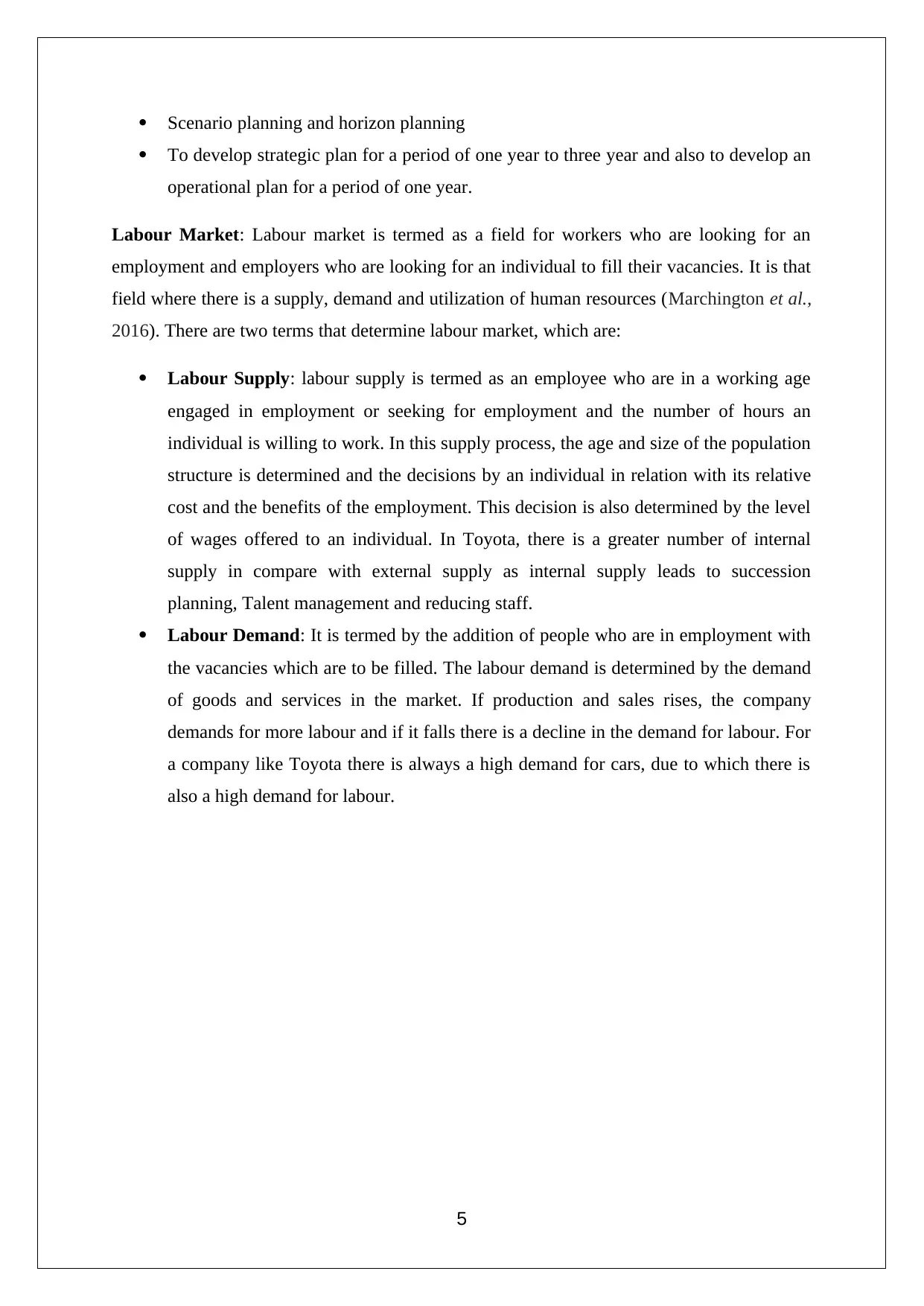
Scenario planning and horizon planning
To develop strategic plan for a period of one year to three year and also to develop an
operational plan for a period of one year.
Labour Market: Labour market is termed as a field for workers who are looking for an
employment and employers who are looking for an individual to fill their vacancies. It is that
field where there is a supply, demand and utilization of human resources (Marchington et al.,
2016). There are two terms that determine labour market, which are:
Labour Supply: labour supply is termed as an employee who are in a working age
engaged in employment or seeking for employment and the number of hours an
individual is willing to work. In this supply process, the age and size of the population
structure is determined and the decisions by an individual in relation with its relative
cost and the benefits of the employment. This decision is also determined by the level
of wages offered to an individual. In Toyota, there is a greater number of internal
supply in compare with external supply as internal supply leads to succession
planning, Talent management and reducing staff.
Labour Demand: It is termed by the addition of people who are in employment with
the vacancies which are to be filled. The labour demand is determined by the demand
of goods and services in the market. If production and sales rises, the company
demands for more labour and if it falls there is a decline in the demand for labour. For
a company like Toyota there is always a high demand for cars, due to which there is
also a high demand for labour.
5
To develop strategic plan for a period of one year to three year and also to develop an
operational plan for a period of one year.
Labour Market: Labour market is termed as a field for workers who are looking for an
employment and employers who are looking for an individual to fill their vacancies. It is that
field where there is a supply, demand and utilization of human resources (Marchington et al.,
2016). There are two terms that determine labour market, which are:
Labour Supply: labour supply is termed as an employee who are in a working age
engaged in employment or seeking for employment and the number of hours an
individual is willing to work. In this supply process, the age and size of the population
structure is determined and the decisions by an individual in relation with its relative
cost and the benefits of the employment. This decision is also determined by the level
of wages offered to an individual. In Toyota, there is a greater number of internal
supply in compare with external supply as internal supply leads to succession
planning, Talent management and reducing staff.
Labour Demand: It is termed by the addition of people who are in employment with
the vacancies which are to be filled. The labour demand is determined by the demand
of goods and services in the market. If production and sales rises, the company
demands for more labour and if it falls there is a decline in the demand for labour. For
a company like Toyota there is always a high demand for cars, due to which there is
also a high demand for labour.
5

B. Identify the organization’s approaches to recruitment and selection and
explain the strengths and weakness of the different approaches.
Recruitment is the process of looking for a desired and potential job candidate. In that way
organization can select the best people to fill the concern job needs in the organization. In this
process an organization can identify its basic needs so that it can utilize someone to fulfil that
needs up to the point (Cuddy, 2015). On the other hand, in the selection process, an
organization can choose the suitable candidates from the application for the required post. An
organization can select the individual who can give best contribution to the organization at
present or in near future. Selecting and appointing individuals to fill the desired post can
either be done through internally or externally (Brewster, 2017).
There are two sources of recruitment, which are internal and external. In both the sources
there are basic strength and weakness that are discussed below:
Internal Recruitment process:
Strength of Internal Recruitment Process: In this recruitment process there is a
considerable retention of monetary source as the employees who have a basic inside
knowledge will take a shorter period of training and adaptation. As it is like an in-
house promotion, helps the employee to motivate and to work in the organization. In
this process, it is easier to recruit as both the candidates and the company are familiar
to each other and the recruiter knows the strength and weakness of the candidate.
Weakness of Internal Recruitment Process: There is also some weakness which
includes a lack of new ideas, facing problem in filling technical vacancies. In this
process an individual have to substitute the person who has been getting promoted. If
there is a promotion of a single employee in the organization, it will disappoint the
other employees.
External Recruitment process:
Strength of External Recruitment Process: When organization wants to recruit
externally, they search for the talent that takes place in either regional, national and
local market or international labour market. In that way an organization can search for
a wider variety of talent. In this process, it helps to catch the new ideas and
knowledge to the company.
Weakness of External Recruitment process: Sometimes External Recruitment also
6
explain the strengths and weakness of the different approaches.
Recruitment is the process of looking for a desired and potential job candidate. In that way
organization can select the best people to fill the concern job needs in the organization. In this
process an organization can identify its basic needs so that it can utilize someone to fulfil that
needs up to the point (Cuddy, 2015). On the other hand, in the selection process, an
organization can choose the suitable candidates from the application for the required post. An
organization can select the individual who can give best contribution to the organization at
present or in near future. Selecting and appointing individuals to fill the desired post can
either be done through internally or externally (Brewster, 2017).
There are two sources of recruitment, which are internal and external. In both the sources
there are basic strength and weakness that are discussed below:
Internal Recruitment process:
Strength of Internal Recruitment Process: In this recruitment process there is a
considerable retention of monetary source as the employees who have a basic inside
knowledge will take a shorter period of training and adaptation. As it is like an in-
house promotion, helps the employee to motivate and to work in the organization. In
this process, it is easier to recruit as both the candidates and the company are familiar
to each other and the recruiter knows the strength and weakness of the candidate.
Weakness of Internal Recruitment Process: There is also some weakness which
includes a lack of new ideas, facing problem in filling technical vacancies. In this
process an individual have to substitute the person who has been getting promoted. If
there is a promotion of a single employee in the organization, it will disappoint the
other employees.
External Recruitment process:
Strength of External Recruitment Process: When organization wants to recruit
externally, they search for the talent that takes place in either regional, national and
local market or international labour market. In that way an organization can search for
a wider variety of talent. In this process, it helps to catch the new ideas and
knowledge to the company.
Weakness of External Recruitment process: Sometimes External Recruitment also
6
⊘ This is a preview!⊘
Do you want full access?
Subscribe today to unlock all pages.

Trusted by 1+ million students worldwide
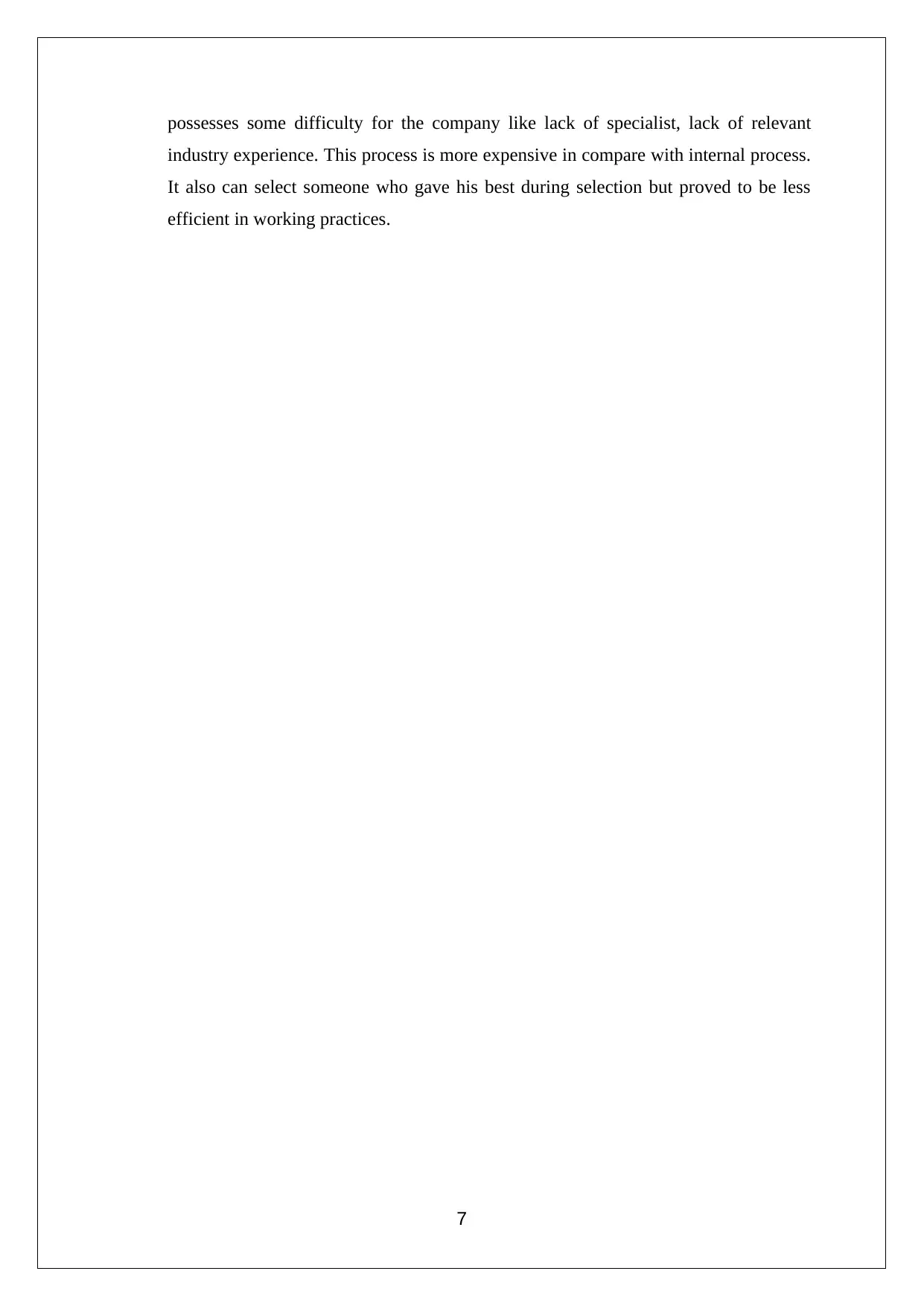
possesses some difficulty for the company like lack of specialist, lack of relevant
industry experience. This process is more expensive in compare with internal process.
It also can select someone who gave his best during selection but proved to be less
efficient in working practices.
7
industry experience. This process is more expensive in compare with internal process.
It also can select someone who gave his best during selection but proved to be less
efficient in working practices.
7
Paraphrase This Document
Need a fresh take? Get an instant paraphrase of this document with our AI Paraphraser
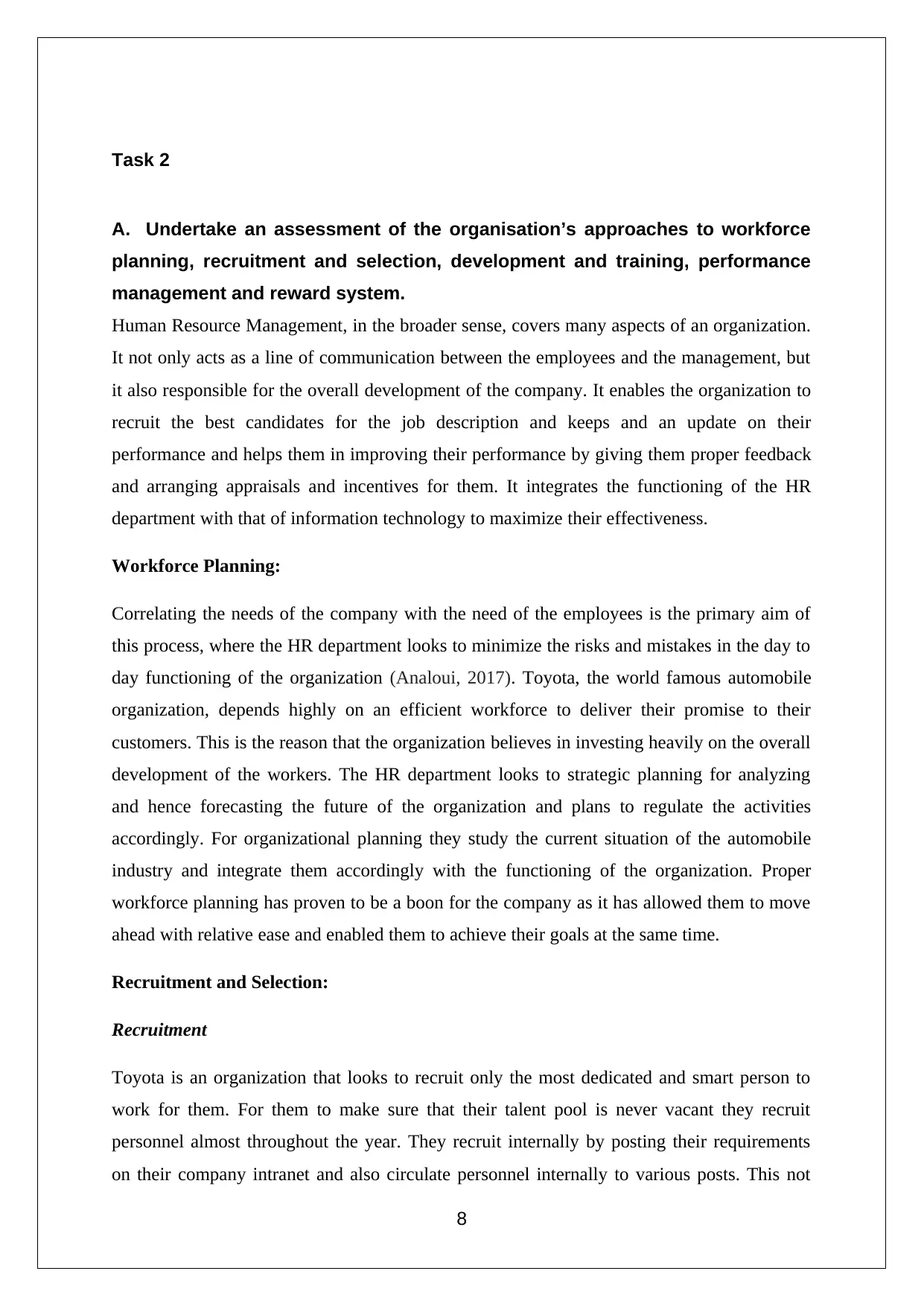
Task 2
A. Undertake an assessment of the organisation’s approaches to workforce
planning, recruitment and selection, development and training, performance
management and reward system.
Human Resource Management, in the broader sense, covers many aspects of an organization.
It not only acts as a line of communication between the employees and the management, but
it also responsible for the overall development of the company. It enables the organization to
recruit the best candidates for the job description and keeps and an update on their
performance and helps them in improving their performance by giving them proper feedback
and arranging appraisals and incentives for them. It integrates the functioning of the HR
department with that of information technology to maximize their effectiveness.
Workforce Planning:
Correlating the needs of the company with the need of the employees is the primary aim of
this process, where the HR department looks to minimize the risks and mistakes in the day to
day functioning of the organization (Analoui, 2017). Toyota, the world famous automobile
organization, depends highly on an efficient workforce to deliver their promise to their
customers. This is the reason that the organization believes in investing heavily on the overall
development of the workers. The HR department looks to strategic planning for analyzing
and hence forecasting the future of the organization and plans to regulate the activities
accordingly. For organizational planning they study the current situation of the automobile
industry and integrate them accordingly with the functioning of the organization. Proper
workforce planning has proven to be a boon for the company as it has allowed them to move
ahead with relative ease and enabled them to achieve their goals at the same time.
Recruitment and Selection:
Recruitment
Toyota is an organization that looks to recruit only the most dedicated and smart person to
work for them. For them to make sure that their talent pool is never vacant they recruit
personnel almost throughout the year. They recruit internally by posting their requirements
on their company intranet and also circulate personnel internally to various posts. This not
8
A. Undertake an assessment of the organisation’s approaches to workforce
planning, recruitment and selection, development and training, performance
management and reward system.
Human Resource Management, in the broader sense, covers many aspects of an organization.
It not only acts as a line of communication between the employees and the management, but
it also responsible for the overall development of the company. It enables the organization to
recruit the best candidates for the job description and keeps and an update on their
performance and helps them in improving their performance by giving them proper feedback
and arranging appraisals and incentives for them. It integrates the functioning of the HR
department with that of information technology to maximize their effectiveness.
Workforce Planning:
Correlating the needs of the company with the need of the employees is the primary aim of
this process, where the HR department looks to minimize the risks and mistakes in the day to
day functioning of the organization (Analoui, 2017). Toyota, the world famous automobile
organization, depends highly on an efficient workforce to deliver their promise to their
customers. This is the reason that the organization believes in investing heavily on the overall
development of the workers. The HR department looks to strategic planning for analyzing
and hence forecasting the future of the organization and plans to regulate the activities
accordingly. For organizational planning they study the current situation of the automobile
industry and integrate them accordingly with the functioning of the organization. Proper
workforce planning has proven to be a boon for the company as it has allowed them to move
ahead with relative ease and enabled them to achieve their goals at the same time.
Recruitment and Selection:
Recruitment
Toyota is an organization that looks to recruit only the most dedicated and smart person to
work for them. For them to make sure that their talent pool is never vacant they recruit
personnel almost throughout the year. They recruit internally by posting their requirements
on their company intranet and also circulate personnel internally to various posts. This not
8
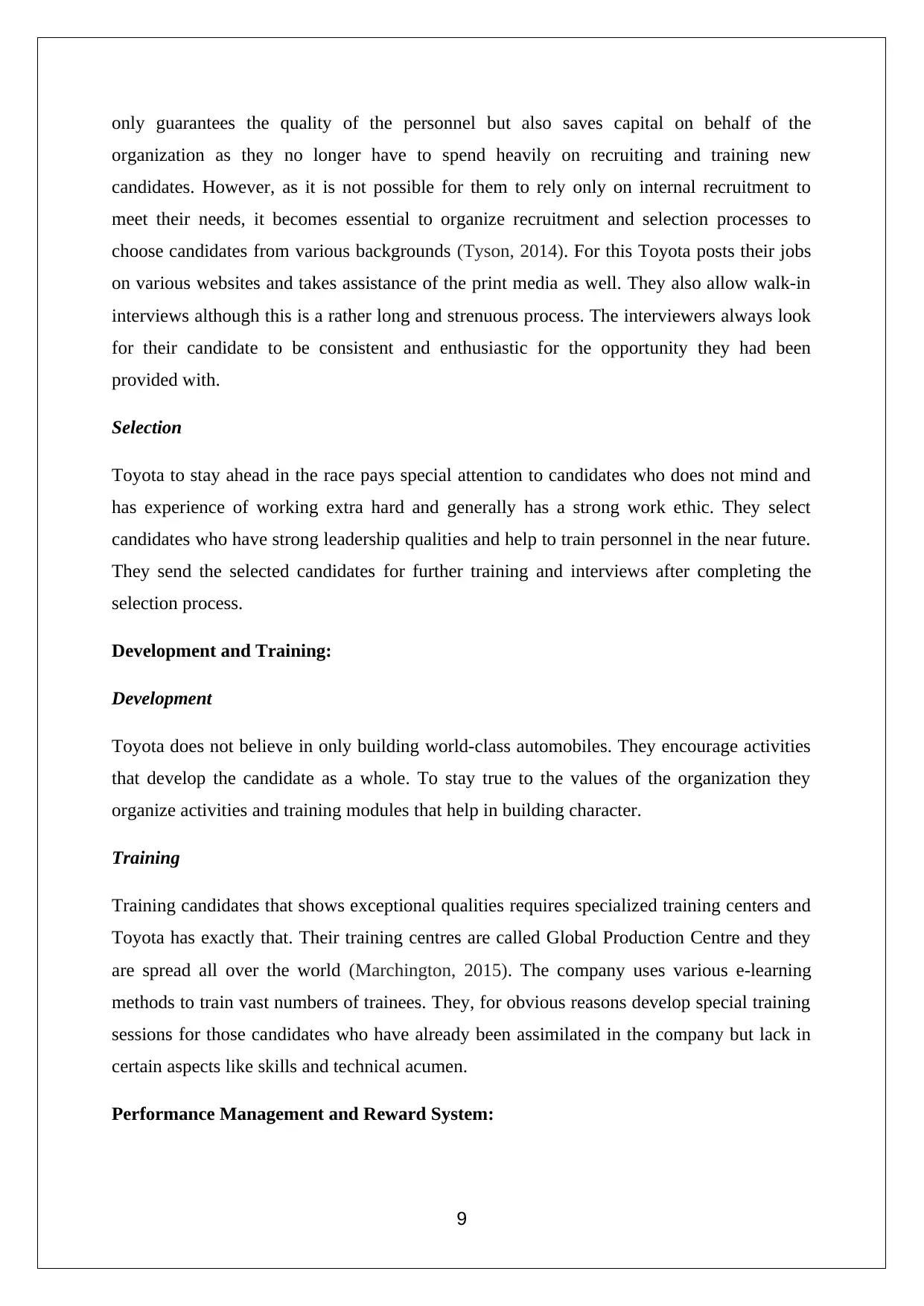
only guarantees the quality of the personnel but also saves capital on behalf of the
organization as they no longer have to spend heavily on recruiting and training new
candidates. However, as it is not possible for them to rely only on internal recruitment to
meet their needs, it becomes essential to organize recruitment and selection processes to
choose candidates from various backgrounds (Tyson, 2014). For this Toyota posts their jobs
on various websites and takes assistance of the print media as well. They also allow walk-in
interviews although this is a rather long and strenuous process. The interviewers always look
for their candidate to be consistent and enthusiastic for the opportunity they had been
provided with.
Selection
Toyota to stay ahead in the race pays special attention to candidates who does not mind and
has experience of working extra hard and generally has a strong work ethic. They select
candidates who have strong leadership qualities and help to train personnel in the near future.
They send the selected candidates for further training and interviews after completing the
selection process.
Development and Training:
Development
Toyota does not believe in only building world-class automobiles. They encourage activities
that develop the candidate as a whole. To stay true to the values of the organization they
organize activities and training modules that help in building character.
Training
Training candidates that shows exceptional qualities requires specialized training centers and
Toyota has exactly that. Their training centres are called Global Production Centre and they
are spread all over the world (Marchington, 2015). The company uses various e-learning
methods to train vast numbers of trainees. They, for obvious reasons develop special training
sessions for those candidates who have already been assimilated in the company but lack in
certain aspects like skills and technical acumen.
Performance Management and Reward System:
9
organization as they no longer have to spend heavily on recruiting and training new
candidates. However, as it is not possible for them to rely only on internal recruitment to
meet their needs, it becomes essential to organize recruitment and selection processes to
choose candidates from various backgrounds (Tyson, 2014). For this Toyota posts their jobs
on various websites and takes assistance of the print media as well. They also allow walk-in
interviews although this is a rather long and strenuous process. The interviewers always look
for their candidate to be consistent and enthusiastic for the opportunity they had been
provided with.
Selection
Toyota to stay ahead in the race pays special attention to candidates who does not mind and
has experience of working extra hard and generally has a strong work ethic. They select
candidates who have strong leadership qualities and help to train personnel in the near future.
They send the selected candidates for further training and interviews after completing the
selection process.
Development and Training:
Development
Toyota does not believe in only building world-class automobiles. They encourage activities
that develop the candidate as a whole. To stay true to the values of the organization they
organize activities and training modules that help in building character.
Training
Training candidates that shows exceptional qualities requires specialized training centers and
Toyota has exactly that. Their training centres are called Global Production Centre and they
are spread all over the world (Marchington, 2015). The company uses various e-learning
methods to train vast numbers of trainees. They, for obvious reasons develop special training
sessions for those candidates who have already been assimilated in the company but lack in
certain aspects like skills and technical acumen.
Performance Management and Reward System:
9
⊘ This is a preview!⊘
Do you want full access?
Subscribe today to unlock all pages.

Trusted by 1+ million students worldwide
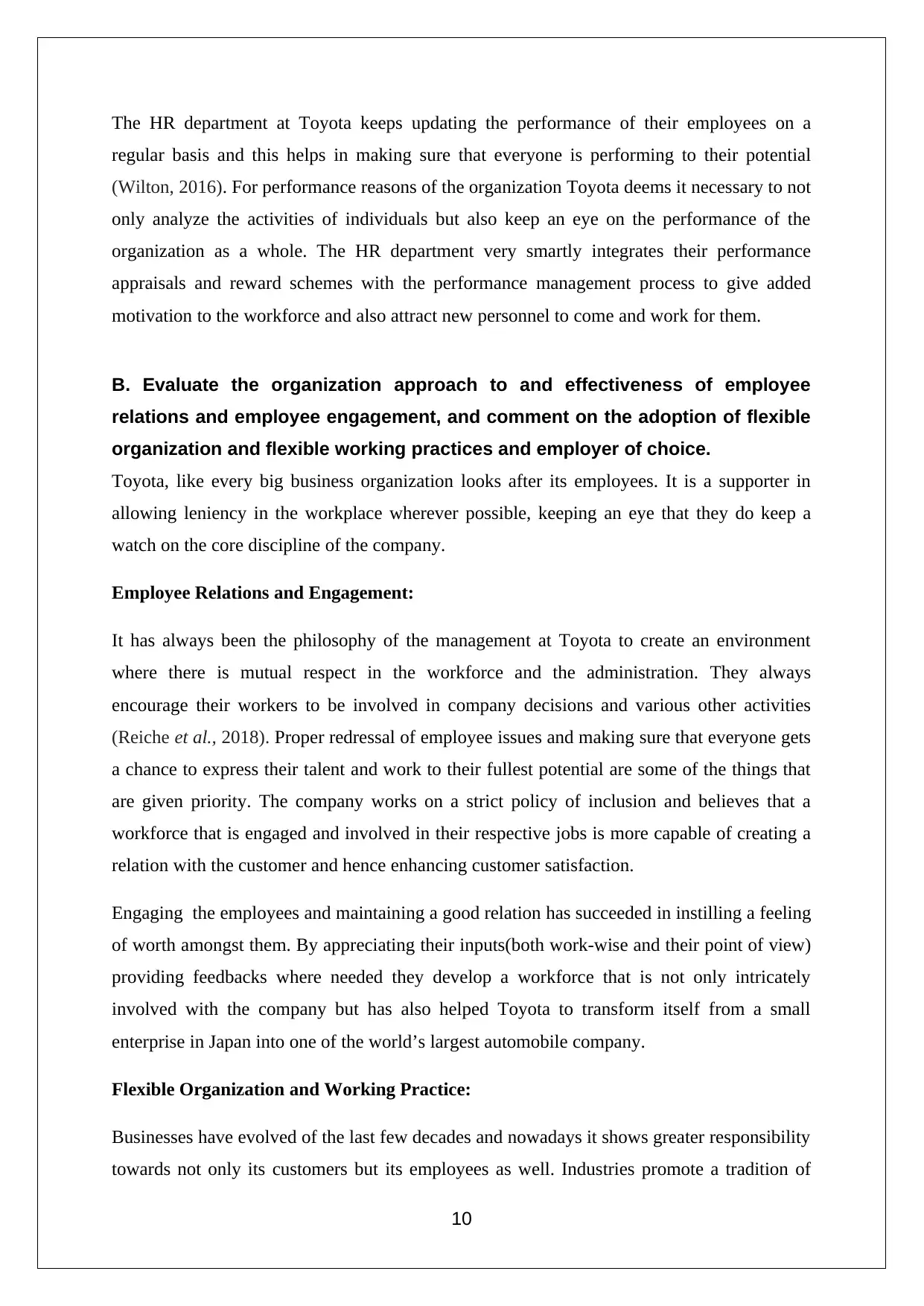
The HR department at Toyota keeps updating the performance of their employees on a
regular basis and this helps in making sure that everyone is performing to their potential
(Wilton, 2016). For performance reasons of the organization Toyota deems it necessary to not
only analyze the activities of individuals but also keep an eye on the performance of the
organization as a whole. The HR department very smartly integrates their performance
appraisals and reward schemes with the performance management process to give added
motivation to the workforce and also attract new personnel to come and work for them.
B. Evaluate the organization approach to and effectiveness of employee
relations and employee engagement, and comment on the adoption of flexible
organization and flexible working practices and employer of choice.
Toyota, like every big business organization looks after its employees. It is a supporter in
allowing leniency in the workplace wherever possible, keeping an eye that they do keep a
watch on the core discipline of the company.
Employee Relations and Engagement:
It has always been the philosophy of the management at Toyota to create an environment
where there is mutual respect in the workforce and the administration. They always
encourage their workers to be involved in company decisions and various other activities
(Reiche et al., 2018). Proper redressal of employee issues and making sure that everyone gets
a chance to express their talent and work to their fullest potential are some of the things that
are given priority. The company works on a strict policy of inclusion and believes that a
workforce that is engaged and involved in their respective jobs is more capable of creating a
relation with the customer and hence enhancing customer satisfaction.
Engaging the employees and maintaining a good relation has succeeded in instilling a feeling
of worth amongst them. By appreciating their inputs(both work-wise and their point of view)
providing feedbacks where needed they develop a workforce that is not only intricately
involved with the company but has also helped Toyota to transform itself from a small
enterprise in Japan into one of the world’s largest automobile company.
Flexible Organization and Working Practice:
Businesses have evolved of the last few decades and nowadays it shows greater responsibility
towards not only its customers but its employees as well. Industries promote a tradition of
10
regular basis and this helps in making sure that everyone is performing to their potential
(Wilton, 2016). For performance reasons of the organization Toyota deems it necessary to not
only analyze the activities of individuals but also keep an eye on the performance of the
organization as a whole. The HR department very smartly integrates their performance
appraisals and reward schemes with the performance management process to give added
motivation to the workforce and also attract new personnel to come and work for them.
B. Evaluate the organization approach to and effectiveness of employee
relations and employee engagement, and comment on the adoption of flexible
organization and flexible working practices and employer of choice.
Toyota, like every big business organization looks after its employees. It is a supporter in
allowing leniency in the workplace wherever possible, keeping an eye that they do keep a
watch on the core discipline of the company.
Employee Relations and Engagement:
It has always been the philosophy of the management at Toyota to create an environment
where there is mutual respect in the workforce and the administration. They always
encourage their workers to be involved in company decisions and various other activities
(Reiche et al., 2018). Proper redressal of employee issues and making sure that everyone gets
a chance to express their talent and work to their fullest potential are some of the things that
are given priority. The company works on a strict policy of inclusion and believes that a
workforce that is engaged and involved in their respective jobs is more capable of creating a
relation with the customer and hence enhancing customer satisfaction.
Engaging the employees and maintaining a good relation has succeeded in instilling a feeling
of worth amongst them. By appreciating their inputs(both work-wise and their point of view)
providing feedbacks where needed they develop a workforce that is not only intricately
involved with the company but has also helped Toyota to transform itself from a small
enterprise in Japan into one of the world’s largest automobile company.
Flexible Organization and Working Practice:
Businesses have evolved of the last few decades and nowadays it shows greater responsibility
towards not only its customers but its employees as well. Industries promote a tradition of
10
Paraphrase This Document
Need a fresh take? Get an instant paraphrase of this document with our AI Paraphraser
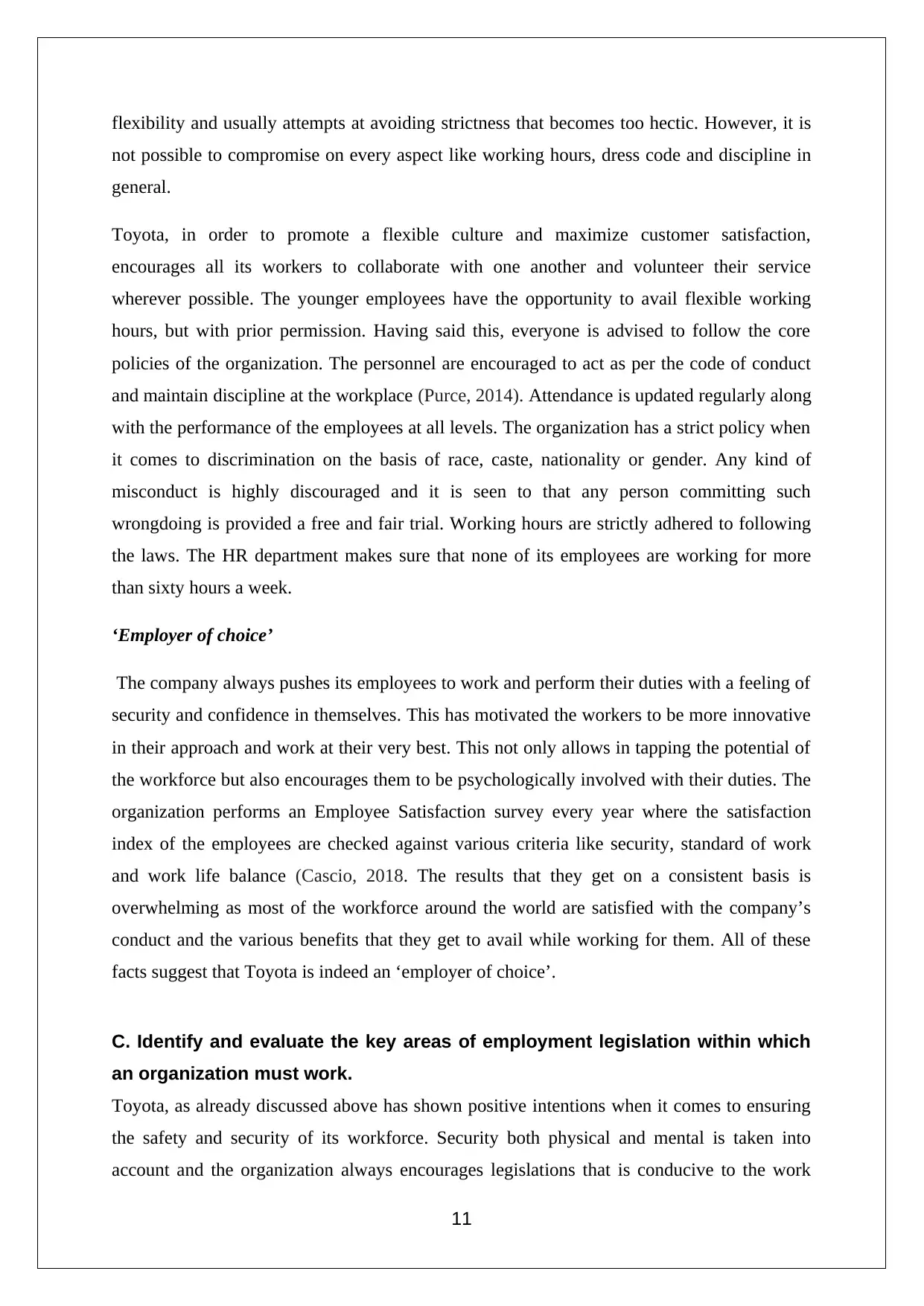
flexibility and usually attempts at avoiding strictness that becomes too hectic. However, it is
not possible to compromise on every aspect like working hours, dress code and discipline in
general.
Toyota, in order to promote a flexible culture and maximize customer satisfaction,
encourages all its workers to collaborate with one another and volunteer their service
wherever possible. The younger employees have the opportunity to avail flexible working
hours, but with prior permission. Having said this, everyone is advised to follow the core
policies of the organization. The personnel are encouraged to act as per the code of conduct
and maintain discipline at the workplace (Purce, 2014). Attendance is updated regularly along
with the performance of the employees at all levels. The organization has a strict policy when
it comes to discrimination on the basis of race, caste, nationality or gender. Any kind of
misconduct is highly discouraged and it is seen to that any person committing such
wrongdoing is provided a free and fair trial. Working hours are strictly adhered to following
the laws. The HR department makes sure that none of its employees are working for more
than sixty hours a week.
‘Employer of choice’
The company always pushes its employees to work and perform their duties with a feeling of
security and confidence in themselves. This has motivated the workers to be more innovative
in their approach and work at their very best. This not only allows in tapping the potential of
the workforce but also encourages them to be psychologically involved with their duties. The
organization performs an Employee Satisfaction survey every year where the satisfaction
index of the employees are checked against various criteria like security, standard of work
and work life balance (Cascio, 2018. The results that they get on a consistent basis is
overwhelming as most of the workforce around the world are satisfied with the company’s
conduct and the various benefits that they get to avail while working for them. All of these
facts suggest that Toyota is indeed an ‘employer of choice’.
C. Identify and evaluate the key areas of employment legislation within which
an organization must work.
Toyota, as already discussed above has shown positive intentions when it comes to ensuring
the safety and security of its workforce. Security both physical and mental is taken into
account and the organization always encourages legislations that is conducive to the work
11
not possible to compromise on every aspect like working hours, dress code and discipline in
general.
Toyota, in order to promote a flexible culture and maximize customer satisfaction,
encourages all its workers to collaborate with one another and volunteer their service
wherever possible. The younger employees have the opportunity to avail flexible working
hours, but with prior permission. Having said this, everyone is advised to follow the core
policies of the organization. The personnel are encouraged to act as per the code of conduct
and maintain discipline at the workplace (Purce, 2014). Attendance is updated regularly along
with the performance of the employees at all levels. The organization has a strict policy when
it comes to discrimination on the basis of race, caste, nationality or gender. Any kind of
misconduct is highly discouraged and it is seen to that any person committing such
wrongdoing is provided a free and fair trial. Working hours are strictly adhered to following
the laws. The HR department makes sure that none of its employees are working for more
than sixty hours a week.
‘Employer of choice’
The company always pushes its employees to work and perform their duties with a feeling of
security and confidence in themselves. This has motivated the workers to be more innovative
in their approach and work at their very best. This not only allows in tapping the potential of
the workforce but also encourages them to be psychologically involved with their duties. The
organization performs an Employee Satisfaction survey every year where the satisfaction
index of the employees are checked against various criteria like security, standard of work
and work life balance (Cascio, 2018. The results that they get on a consistent basis is
overwhelming as most of the workforce around the world are satisfied with the company’s
conduct and the various benefits that they get to avail while working for them. All of these
facts suggest that Toyota is indeed an ‘employer of choice’.
C. Identify and evaluate the key areas of employment legislation within which
an organization must work.
Toyota, as already discussed above has shown positive intentions when it comes to ensuring
the safety and security of its workforce. Security both physical and mental is taken into
account and the organization always encourages legislations that is conducive to the work
11
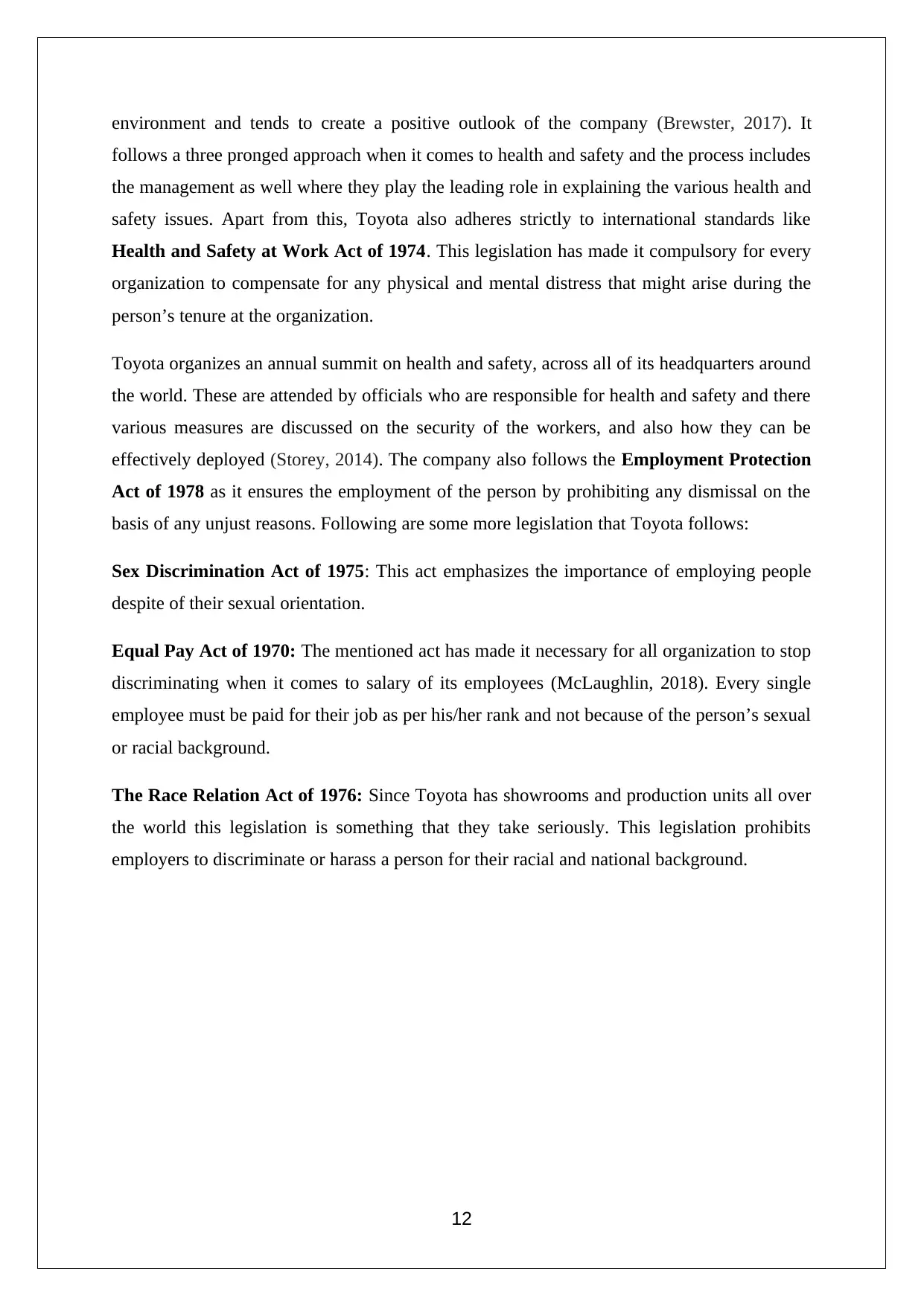
environment and tends to create a positive outlook of the company (Brewster, 2017). It
follows a three pronged approach when it comes to health and safety and the process includes
the management as well where they play the leading role in explaining the various health and
safety issues. Apart from this, Toyota also adheres strictly to international standards like
Health and Safety at Work Act of 1974. This legislation has made it compulsory for every
organization to compensate for any physical and mental distress that might arise during the
person’s tenure at the organization.
Toyota organizes an annual summit on health and safety, across all of its headquarters around
the world. These are attended by officials who are responsible for health and safety and there
various measures are discussed on the security of the workers, and also how they can be
effectively deployed (Storey, 2014). The company also follows the Employment Protection
Act of 1978 as it ensures the employment of the person by prohibiting any dismissal on the
basis of any unjust reasons. Following are some more legislation that Toyota follows:
Sex Discrimination Act of 1975: This act emphasizes the importance of employing people
despite of their sexual orientation.
Equal Pay Act of 1970: The mentioned act has made it necessary for all organization to stop
discriminating when it comes to salary of its employees (McLaughlin, 2018). Every single
employee must be paid for their job as per his/her rank and not because of the person’s sexual
or racial background.
The Race Relation Act of 1976: Since Toyota has showrooms and production units all over
the world this legislation is something that they take seriously. This legislation prohibits
employers to discriminate or harass a person for their racial and national background.
12
follows a three pronged approach when it comes to health and safety and the process includes
the management as well where they play the leading role in explaining the various health and
safety issues. Apart from this, Toyota also adheres strictly to international standards like
Health and Safety at Work Act of 1974. This legislation has made it compulsory for every
organization to compensate for any physical and mental distress that might arise during the
person’s tenure at the organization.
Toyota organizes an annual summit on health and safety, across all of its headquarters around
the world. These are attended by officials who are responsible for health and safety and there
various measures are discussed on the security of the workers, and also how they can be
effectively deployed (Storey, 2014). The company also follows the Employment Protection
Act of 1978 as it ensures the employment of the person by prohibiting any dismissal on the
basis of any unjust reasons. Following are some more legislation that Toyota follows:
Sex Discrimination Act of 1975: This act emphasizes the importance of employing people
despite of their sexual orientation.
Equal Pay Act of 1970: The mentioned act has made it necessary for all organization to stop
discriminating when it comes to salary of its employees (McLaughlin, 2018). Every single
employee must be paid for their job as per his/her rank and not because of the person’s sexual
or racial background.
The Race Relation Act of 1976: Since Toyota has showrooms and production units all over
the world this legislation is something that they take seriously. This legislation prohibits
employers to discriminate or harass a person for their racial and national background.
12
⊘ This is a preview!⊘
Do you want full access?
Subscribe today to unlock all pages.

Trusted by 1+ million students worldwide
1 out of 21
Related Documents
Your All-in-One AI-Powered Toolkit for Academic Success.
+13062052269
info@desklib.com
Available 24*7 on WhatsApp / Email
![[object Object]](/_next/static/media/star-bottom.7253800d.svg)
Unlock your academic potential
Copyright © 2020–2025 A2Z Services. All Rights Reserved. Developed and managed by ZUCOL.





